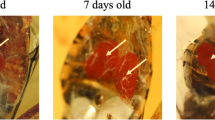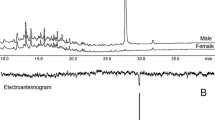Abstract
Production of the male specific compound, 6,10,13-trimethyltetra- decyl isovalerate by the predatory stink bug Eocanthecona furcellata (Wolff) was dramatically affected by rearing conditions. Male bugs kept isolated after eclosion produced an average of 1,948 ng of 6,10,13-trimethyltetradecyl isovalerate per bug, whereas male bugs reared in groups of 5–8 bugs produced an average of only 4 ng of 6,10,13-trimethyltetradecyl isovalerate per bug. Same-sex or mixed-sex pairs of bugs produced less than 50 ng per bug. Male bugs kept isolated for 1~wk and then grouped for 1~wk produced 3 ng of 6,10,13-trimethyltetradecyl isovalerate per bug, whereas male bugs grouped first and then isolated produced 135 ng of 6,10,13-trimethyltetradecyl isovalerate. A total of 11 minor components in relative amounts of less than 1% of the major 6,10,13-trimethyltetradecyl isovalerate were found in the sternal gland secretion. These included 6,10,13-trimethyltetradecanol, acetate, propionate, and butyrate esters of 6,10,13-trimethyltetradecanol, and isovalerate or valerate esters of homologs of 6,10,13-trimethyltetradecanol.
Similar content being viewed by others
References
Aldrich, J. R. and Lusby, W. R. 1986. Exocrine chemistry of beneficial insects: Male-specific secretions from predatory stink bugs (Hemiptera: Pentatomidae). Comp. Biochem. Physiol. 85B:639–642.
Aldrich, J. R., Oliver, J. E., Lusby, W. R., and Kochansky, J. P. 1986. Identification of male-specific exocrine secretions from predatory stink bugs (Hemiptera, Pentatomidae). Arch. Insect Biochem. Physiol. 3:1–12.
Chu, Y. I. and Chu, C. M. 1975a. Life history and the effect of temperature on the growth of Eocanthecona furcellata (Wolff) [for biological control of insect pests, Pieris rapae, Spodoptera litura, Anomia flava flava] Chung-Hua-Chih-Wu-Pao-Hu-Husueh-Hui Plant Prot. Bull. 17:99–114 [in Chinese].
Chu, Y. I. and Chu, C. M. 1975b. Feeding habit of Eocanthecona furcellata (Wolff) [Biological control of insect pests, Chilo suppressalis, Pieris rapae, Pyrausta nubiralis, Spodoptera litura] Chung-Hua-Chih-Wu-Pao-Hu-Husueh-Hui Plant Prot. Bull. 17:133–141 [in Chinese].
Ho, H. Y., Kou, R., and Tseng, H. K. 2003. Semiochemicals from the predatory stink bug Eocanthecona furcellata (Wolff): components of metathoracic gland, dorsal abdominal gland, and sternal gland secretions. J. Chem. Ecol. 29:2101–2114.
Kochansky, J. P., Aldrich, J. R., and Lusby, W. R. 1989. Synthesis and pheromonal activity of 6,10,13-trimethyl-1-tetradecanol for predatory stink bug, Stiretrus anchorago (Heteroptera: Pentatomidae). J. Chem. Ecol. 15:1717–1728.
Mclafferty, F. W. 1980. Interpretation of Mass Spectra, pp. 201–206. University Science Books, Mill Valley, CA.
Author information
Authors and Affiliations
Corresponding author
Rights and permissions
About this article
Cite this article
HO, HY., HSU, YC., CHUANG, YC. et al. EFFECT OF REARING CONDITIONS ON PRODUCTION OF STERNAL GLAND SECRETION, AND IDENTIFICATION OF MINOR COMPONENTS IN THE STERNAL GLAND SECRETION OF THE PREDATORY STINK BUG Eocanthecona furcellata. J Chem Ecol 31, 29–37 (2005). https://doi.org/10.1007/s10886-005-0971-7
Issue Date:
DOI: https://doi.org/10.1007/s10886-005-0971-7




